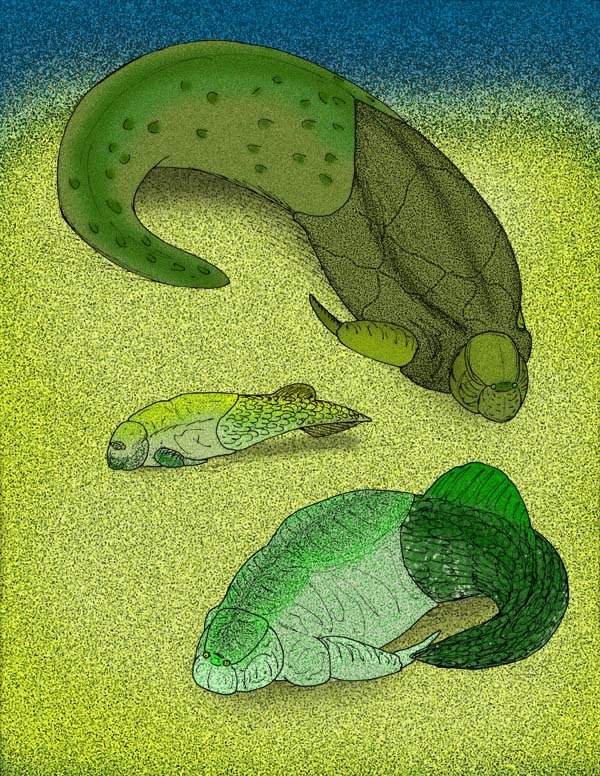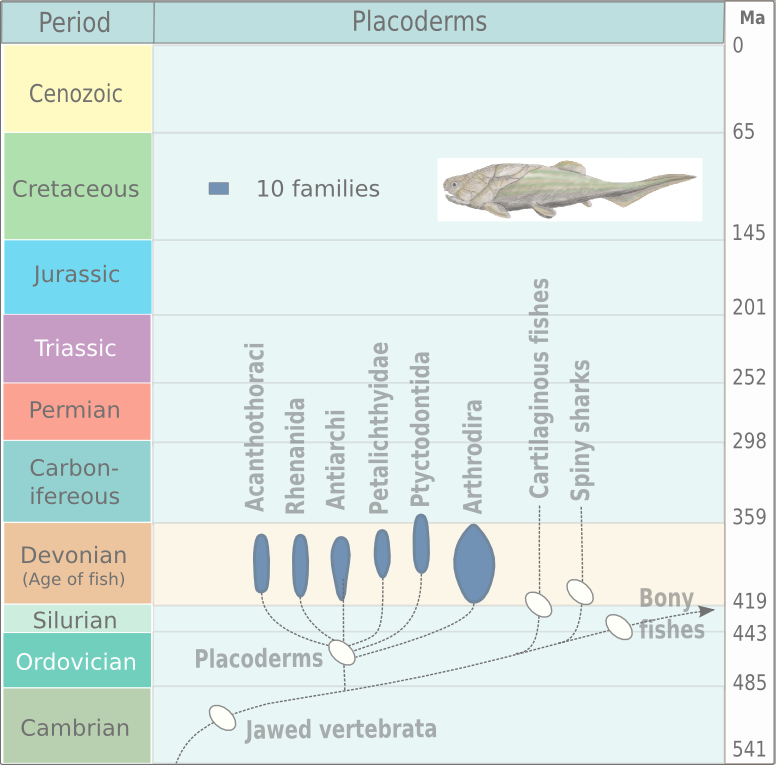|
Yunnanolepis
''Yunnanolepis'' is an extinct genus of primitive antiarch placoderm. The fossils of the various species are found in Early to Middle Devonian strata in Southern China ( Xishancun, Lianhuashan and Xitun Formations). External links ''Yunnanolepis''at the Paleobiology Database The Paleobiology Database (PBDB) is an online resource for information on the distribution and classification of fossil animals, plants, and microorganisms. History The Paleobiology Database originated in the NCEAS-funded Phanerozoic Marine Pale ... Antiarchi Placoderm genera Placoderms of Asia Lochkovian life Fossils of China Paleontology in Yunnan Fossil taxa described in 1963 {{placoderm-stub ... [...More Info...] [...Related Items...] OR: [Wikipedia] [Google] [Baidu] |
Antiarch
Antiarchi ("opposite anus") is an order of heavily armored placoderms. The antiarchs form the second-most successful group of placoderms after the arthrodires in terms of numbers of species and range of environments. The order's name was coined by Edward Drinker Cope, who, when examining some fossils that he thought were armored tunicates related to '' Chelyosoma'', mistakenly thought that the orbital fenestra (i.e., the hole in the headshield for the eyes, nose and pineal foramen) was the opening for the mouth, or oral siphon, and that the opening for the anal siphon was on the other side of the body, as opposed to having both oral and anal siphons together at one end. The front portions of their bodies were heavily armored, to the point of literally resembling a box with eyes, with the sometimes scaled, sometimes naked rear portions often becoming sinuous, particularly with later forms. The pair of pectoral fins were modified into a pair of caliper-like, or arthropod-like l ... [...More Info...] [...Related Items...] OR: [Wikipedia] [Google] [Baidu] |
Placoderm
Placoderms (from Ancient Greek πλάξ [''plax'', ''plakos''] 'Plate (animal anatomy), plate' and δέρμα [''derma''] 'skin') are vertebrate animals of the class (biology), class Placodermi, an extinct group of prehistoric fish known from Paleozoic fossils during the Silurian and the Devonian geological period, periods. While their endoskeletons are mainly cartilaginous, their head and thorax were covered by articulated armour (zoology), armoured plates (hence the name), and the rest of the body was scale (zoology), scaled or naked depending on the species. Placoderms were among the first jawed fish (their fish jaw, jaws likely Evolution, evolved from the first pair of gill arches), as well as the first vertebrates to have true tooth, teeth. They were also the first fish clade to develop pelvic fins, the second set of paired fins and the homology (biology), homologous precursor to hindlimbs in tetrapods. 380-million-year-old fossils of three other genera, ''Incisoscutum'', ''M ... [...More Info...] [...Related Items...] OR: [Wikipedia] [Google] [Baidu] |
Antiarchi
Antiarchi ("opposite anus") is an order of heavily armored placoderms. The antiarchs form the second-most successful group of placoderms after the arthrodires in terms of numbers of species and range of environments. The order's name was coined by Edward Drinker Cope, who, when examining some fossils that he thought were armored tunicates related to '' Chelyosoma'', mistakenly thought that the orbital fenestra (i.e., the hole in the headshield for the eyes, nose and pineal foramen) was the opening for the mouth, or oral siphon, and that the opening for the anal siphon was on the other side of the body, as opposed to having both oral and anal siphons together at one end. The front portions of their bodies were heavily armored, to the point of literally resembling a box with eyes, with the sometimes scaled, sometimes naked rear portions often becoming sinuous, particularly with later forms. The pair of pectoral fins were modified into a pair of caliper-like, or arthropod-like l ... [...More Info...] [...Related Items...] OR: [Wikipedia] [Google] [Baidu] |
Placoderm Genera
Placoderms (from Ancient Greek πλάξ 'plax'', ''plakos''' plate' and δέρμα 'derma'''skin') are vertebrate animals of the class Placodermi, an extinct group of prehistoric fish known from Paleozoic fossils during the Silurian and the Devonian periods. While their endoskeletons are mainly cartilaginous, their head and thorax were covered by articulated armoured plates (hence the name), and the rest of the body was scaled or naked depending on the species. Placoderms were among the first jawed fish (their jaws likely evolved from the first pair of gill arches), as well as the first vertebrates to have true teeth. They were also the first fish clade to develop pelvic fins, the second set of paired fins and the homologous precursor to hindlimbs in tetrapods. 380-million-year-old fossils of three other genera, '' Incisoscutum'', '' Materpiscis'' and '' Austroptyctodus'', represent the oldest known examples of live birth. Placoderms are thought to be paraphyletic, cons ... [...More Info...] [...Related Items...] OR: [Wikipedia] [Google] [Baidu] |
Placoderms Of Asia
Placoderms (from Ancient Greek πλάξ [''plax'', ''plakos''] 'Plate (animal anatomy), plate' and δέρμα [''derma''] 'skin') are vertebrate animals of the class (biology), class Placodermi, an extinct group of prehistoric fish known from Paleozoic fossils during the Silurian and the Devonian geological period, periods. While their endoskeletons are mainly cartilaginous, their head and thorax were covered by articulated armour (zoology), armoured plates (hence the name), and the rest of the body was scale (zoology), scaled or naked depending on the species. Placoderms were among the first jawed fish (their fish jaw, jaws likely Evolution, evolved from the first pair of gill arches), as well as the first vertebrates to have true tooth, teeth. They were also the first fish clade to develop pelvic fins, the second set of paired fins and the homology (biology), homologous precursor to hindlimbs in tetrapods. 380-million-year-old fossils of three other genera, ''Incisoscutum'', ''M ... [...More Info...] [...Related Items...] OR: [Wikipedia] [Google] [Baidu] |
Xitun Formation
The Xitun Formation is a paleontology, palaeontological formation which is named after Xitun village in Qujing, a location in Northern and southern China, South China. This formation includes many remains of fossilized fish and plants of the Early Devonian Geologic period, period (Late Lochkovian). It was originally referred to as the Xitun Member of the Cuifengshan Formation (now the Cuifengshan Group). Fossil content Animals Acanthodians Actinopterygians Arthropods Chondrichthyes Jawless fish Placoderms Sarcopterygians Plants See also * List of fossil sites— ''(with link directory)'' References Devonian System of Asia Devonian China Devonian northern paleotropical deposits Paleontology in China Long stubs with short prose {{China-geologic-formation-stub ... [...More Info...] [...Related Items...] OR: [Wikipedia] [Google] [Baidu] |
Early Devonian
The Early Devonian is the first of three Epoch (geology), epochs comprising the Devonian period, corresponding to the Lower Devonian Series (stratigraphy), series. It lasted from and began with the Lochkovian Stage , which was followed by the Pragian from and then by the Emsian, which lasted until the Middle Devonian began, . During this time, the first Ammonoidea, ammonoids appeared, descending from Bactritida, bactritoid Nautiloidea, nautiloids. Ammonoids during this time period were simple and differed little from their nautiloid counterparts. These ammonoids belong to the order Agoniatitida, which in later epochs evolved to new ammonoid orders, for example Goniatite, Goniatitida and Clymeniida. This class of cephalopod molluscs would dominate the marine fauna until the beginning of the Mesozoic Era. References Early Devonian, Geological epochs Devonian geochronology, *01 {{Geochronology-stub ... [...More Info...] [...Related Items...] OR: [Wikipedia] [Google] [Baidu] |
Middle Devonian
In the geological timescale, the Middle Devonian epoch (from 393.3 ± 1.2 million years ago to 382.7 ± 1.6 million years ago) occurred during the Devonian period, after the end of the Emsian age. The Middle Devonian epoch is subdivided into two stages: Eifelian and Givetian. Life in the Middle Devonian In the middle Devonian the armored jawless fish known as ostracoderms were declining in diversity and instead the jawed fish were thriving and increasing in diversity in both the oceans and freshwater. The shallow, warm, oxygen-depleted waters of Devonian inland lakes, surrounded by primitive plants, provided the environment necessary for certain early fish to develop essential characteristics such as well developed lungs, ability to crawl out of the water and onto the land for short periods of time, possibly in search of food which would be developed by the tetrapods later in the Late Devonian which are descendents of these early fish. The earliest forest grew in the Middle De ... [...More Info...] [...Related Items...] OR: [Wikipedia] [Google] [Baidu] |
Devonian
The Devonian ( ) is a period (geology), geologic period and system (stratigraphy), system of the Paleozoic era (geology), era during the Phanerozoic eon (geology), eon, spanning 60.3 million years from the end of the preceding Silurian period at million years ago (Megaannum, Ma), to the beginning of the succeeding Carboniferous period at Ma. It is the fourth period of both the Paleozoic and the Phanerozoic. It is named after Devon, South West England, where rocks from this period were first studied. The first significant evolutionary radiation of history of life#Colonization of land, life on land occurred during the Devonian, as free-spore, sporing land plants (pteridophytes) began to spread across dry land, forming extensive coal forests which covered the continents. By the middle of the Devonian, several groups of vascular plants had evolved leaf, leaves and true roots, and by the end of the period the first seed-bearing plants (Pteridospermatophyta, pteridospermatophyt ... [...More Info...] [...Related Items...] OR: [Wikipedia] [Google] [Baidu] |
China
China, officially the People's Republic of China (PRC), is a country in East Asia. With population of China, a population exceeding 1.4 billion, it is the list of countries by population (United Nations), second-most populous country after India, representing 17.4% of the world population. China spans the equivalent of five time zones and Borders of China, borders fourteen countries by land across an area of nearly , making it the list of countries and dependencies by area, third-largest country by land area. The country is divided into 33 Province-level divisions of China, province-level divisions: 22 provinces of China, provinces, 5 autonomous regions of China, autonomous regions, 4 direct-administered municipalities of China, municipalities, and 2 semi-autonomous special administrative regions. Beijing is the country's capital, while Shanghai is List of cities in China by population, its most populous city by urban area and largest financial center. Considered one of six ... [...More Info...] [...Related Items...] OR: [Wikipedia] [Google] [Baidu] |
Xishancun Formation
The Xishancun Formation is a geological formation located at Qujing, Yunnan, South China. Xishancun Formation has remains of petalichthyid and galeaspid fish and it represents the Early Devonian period (Early Lochkovian) of China. See also * List of fossil sites This list of fossil sites is a worldwide list of localities known well for the presence of fossils. Some entries in this list are notable for a single, unique find, while others are notable for the large number of fossils found there. Many of ... ''(with link directory)'' Devonian System of Asia Devonian China Devonian northern paleotropical deposits Paleontology in Yunnan {{China-geologic-formation-stub ... [...More Info...] [...Related Items...] OR: [Wikipedia] [Google] [Baidu] |
Lianhuashan Formation
Linfa or Lin Fa may refer to: Tropical cyclones * List of storms named Linfa, a list of tropical cyclones named Linfa Plants *''Nelumbo nucifera'', a flower named Linfa in Cantonese *'' Oroxylum indicum'', also called Linfa in Loei People * Linfa Wang, professor at Duke-NUS Medical School, Singapore Places * Lotus Hill, a hill in Guangdong also named Linfa Hill, Guangdong * Lianhuashan Park, a park in Shenzhen also named Linfa Hill, Shenzhen *Lin Fa Shan, a mountain in Lantau, Hong Kong *Lin Fa Shan, Tsuen Wan, a mountain in Tsuen Wan, Hong Kong * Lin Fa Temple, a temple in Wan Chai, Hong Kong * Lin Fa Tei, a village in Yuen Long Yuen Long is a town in the western New Territories, Hong Kong. To its west lie Hung Shui Kiu (), Tin Shui Wai, Lau Fau Shan and Ha Tsuen, to the south Shap Pat Heung and Tai Tong, to the east Au Tau and Kam Tin (), and to the north Nam Sang Wa ..., Hong Kong See also * {{dab ... [...More Info...] [...Related Items...] OR: [Wikipedia] [Google] [Baidu] |





